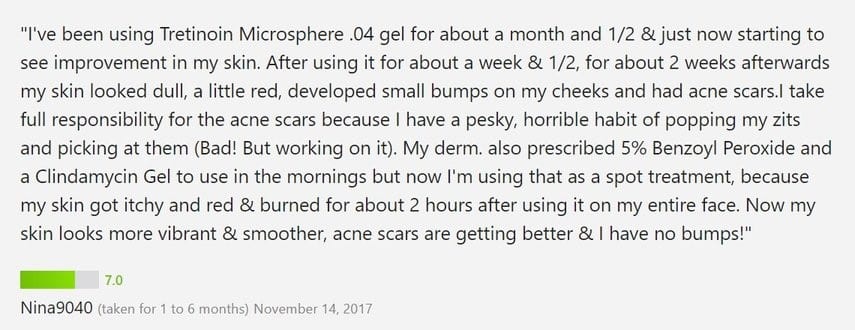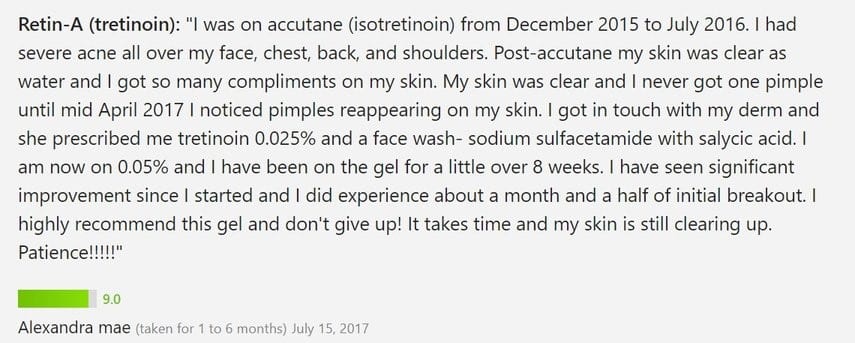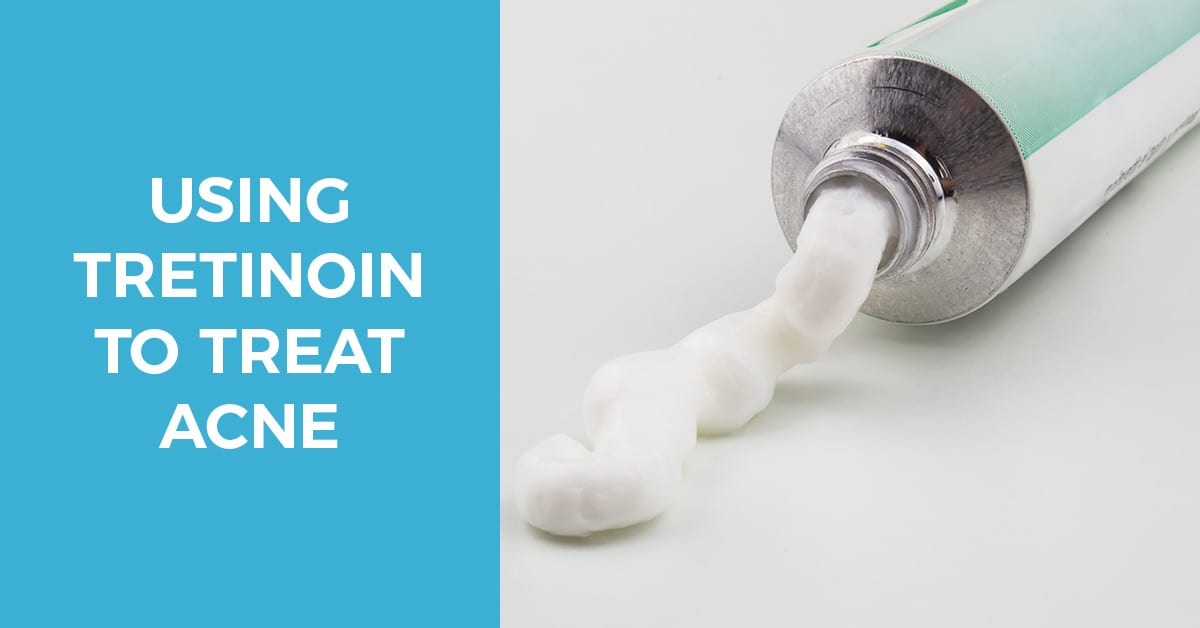Contents
Acne causes tons of problems for many people around the world. Its unwanted presence on the skin is a common cause for stress and social disabilities and while acne is primarily attributed to being a part of becoming a teenager, which supposedly ends with no trace, some types of acne, combined with the individual chemistry of a given person, prove to be a lot more stubborn and persist through the years.
Today we take a detailed look at an effective acne treatment medication called Tretinoin, understand how it works, possible side effects, precautions, and how to use it correctly.
What is Tretinoin?
Tretinoin (available as a gel, cream or solution) is a form of Retin-A drug used to treat mild to moderate acne and minor acne scars. Retin-A is a derivative of Vitamin A, which carries powerful acne combating and anti-aging properties. There are two common variations of Retin-A – prescriptive and topical. While the topical version is less powerful compared to the prescriptive one, it can still produce formidable results when dealing with stubborn acne that doesn’t respond to over-the-counter treatments and is easily acquired on the internet.
It’s important not to confuse Retin-A with Retinol. These two sounds very similar and although both are derived from Vitamin A, they are not the same. Retinol is mainly used for its anti-aging properties, however, it’s a lot weaker compared to Retin-A when it comes to combating acne and can’t be used as a substitute.
How Does Tretinoin Work?

How Tretinoin Works
Tretinoin acts as a comedolytic (inhibiting the formation of comedones and blemishes that occur when excess oil and dirt is trapped inside a pore due to excessive clogging) and hinders pore blockages, preventing blackheads and pimples from forming. It does so by speeding up cell life cycle, which is a 21 day period that causes skin cells to get pushed to the surface of the skin. This happens for both normal and infected skin cells.
As the skin gets clearer, Tretinoin stimulates skin growth around the pore making it look smaller, which opens up naturally via squeezing and doesn’t leave anything inside the skin. It also prevents the future formation of pores, which helps keep the skin free from blemishes, pimps, cysts, blackheads and whiteheads.
Like Retinol, Retin-A also carries some anti-aging and nourishing properties, which help deal with minor acne scars and make them less obvious, and also help fade discolorations that is left after acne is gone. This happens because during the exfoliation, Tretinoin also removes excess melanin – the pigment that gives skin its color – therefore, removing discolorations which are caused by hyperpigmentation (excess melanin in the acne site that causes the skin to look darker).
Apart from combating acne, Retin-A also removes age marks and wrinkles, making the skin look stronger, younger and brighter.
What Tretinoin Struggles to Treat
There are acne types that do not respond well to Tretinoin treatment. For instance, an acne, cyst or ingrown hair that has stayed inside the skin long enough to get covered with a pinkish layer won’t respond well. Moreover, Tretinoin can make those look even worse, since the skin growth stimulation will not be strong enough to make the cysts open up and as a result, they’ll just get bigger and redder.
Similarly, bigger pimps and cysts will take longer to treat. They will require more stimulation and get bigger and redder in the process, especially when the skin has deep pores. Smaller cysts on a tighter skin on the other hand, will be easier to deal with.
Tretinoin and the Sun Interaction
Non-prescriptive Tretinoin isn’t that strong to make the skin super-sensitive to sunlight, but even so, it is highly recommended to use it in the evening. If you’re using Tretinoin during the day and plan to go out into the sun, always apply sunscreen for protection – even if you have dark skin.
Various formulations of Tretinoin (depending on the brand) often include skin lightening agents – hydroquinone and mequinol – to help deal with hyperpigmentation. Hydroquinone in particular can be bad for dark and Asian skin types, leaving permanent black and blue marks on the nose, cheeks and ears.
Tretinoin combined with mequinol can make the treated skin look very pale, which is bad for black and brown skins. Be careful with these products if you have a darker toned skin type and use separate anti-pigmentation solutions containing arbutin after Tretinoin treatment (a variation that doesn’t have any skin lightening agents in the mix) has done its part.
It usually takes 8-12 weeks of dedicated use to start noticing positive improvements via Tretinoin treatment, and another month or two to completely eliminate acne.
As a general rule, during the first few weeks of using Tretinoin, your acne will get worse before it gets better. Regular use is essential for the treatment to be successful. Never apply a bigger amount of the product in an attempt to speed up the healing process – you’ll only make it worse and cause unnecessary irritation, redness and pain.
Tretinoin can harm an unborn baby, which makes it completely contraindicated to pregnant women, or women who plan to become pregnant during the treatment. After the treatment is done, consult a doctor before attempting to get pregnant to make sure everything is fine and no potential harm can be done to your child.
Topical Tretinoin usually comes in 0.01%, 0.02%, 0.025%, 0.375%, 0.04%, 0.05%, and 0.10% strengths. 0.05% is the most common version available on the internet, however, like with any other strong medication, it is advisable to start with the weakest version and increase the dose with each new tube. Tretinoin is not suited for children under 12 (even the 0.01% one).
Most people have close to no problems when using the 0.025% version, and in case of experiencing irritation, adjusting the dose to fit the individual case and minimize side-effects is a sufficient measure. Given all this, I’d still recommend to get a consultation with a professional to better understand your skin and which strength is right for you to start the treatment with. Better safe than sorry.
Before using Tretinoin make sure to:
- Wash your hands thoroughly with warm water.
- Gently cleanse the affected skin areas with a mild or soapless cleanser and pat dry. Wait around 30 minutes.
- With the help of your fingertips, apply a thin layer of the product (gel or cream) over the affected skin once a day, before bed.
- If you’re using a solution, use a cotton tab to apply the liquid.
- Wash your hands thoroughly again after you’re done, to avoid getting the product into the eyes or mouth.
Tretinoin should be used only for the skin. Avoid applying it (even accidentally) to your lips, mouth, nose or eyes. Do not use Tretinoin on cut, scraped, sunburned (unless the version that you got specifically treats sunburns like Renova lotion) skin. If you have any skin conditions (eczema for instance), make sure to consult a dermatologist before using Tretinoin.
While Tretinoin doesn’t usually cause any serious side effects, they can still happen and you need to be ready.
Mild side effects include mild burning, redness, itching, dryness and worsening of acne during the first month. These effects usually become less aggressive with continuous use. In case those effects worsen or persist longer than a month, seek medical help. You might need to decrease the strength or stop using the product entirely.
More severe side effects include blistering, crusting, severe burning, skin swelling, eye redness and watering, eyelid swelling and skin discoloration. Seek immediate medical help if any of those occur.
Allergic reactions are also very rare, but they are a possibility. Again, seek immediate medical help if you experience rash, face/tongue/throat swelling, severe dizziness and difficulty breathing.
Precautions
First of all it’s important to know whether you’re allergic to Vitamin-A related drugs, or any other types of medication. Tretinoin products may contain inactive ingredients that may cause allergic reactions.
Tretinoin, especially the prescriptive version, will make your skin really vulnerable to sunlight. It’s important to use the drug in the evenings and avoid any sun exposure a few hours before and after using the gel. If your skin is especially prone to sunburns, consider using sunscreen during the day for the whole treatment period.
Avoid waxing and chemical depilatories hair removal during the treatment period.
Be careful when using Tretinoin in combination with other skincare products, particularly those containing sulfur or salicylic acid. The reaction between those products may cause unwanted side effects in the form of burns. Wait until the effect of sulfur and salicylic acid completely wears off before going forward with Tretinoin.
Finally, Tretinoin is contraindicated to pregnant and breastfeeding women.
Other Ingredient/Product/Drug Interactions
Apart from sulfur and salicylic acid, there is a long list of common products that, when used together/during the treatment period with Tretinoin, can cause side effects. These products include hair perming solutions, alcohol, lime and menthol containing products that interact with your skin (like toners, shaving lotions, etc.), medicated soaps and soap containing cleansers, cosmetic products with strong drying effects, sulfa based drugs and drugs that may cause increased sun sensitivity (like tetracyclines). Benzoyl peroxide containing products can significantly decrease the effectiveness of Tretinoin when used at the same time.
The complete list of products is a lot longer and fairly complicated, which means that it’s a good idea to consult a professional before going for Tretinoin treatment, especially if you’re consuming other drugs.
Keep in mind that all the above mentioned side effects may or may not occur in a given case, depending on the individual chemistry of each person. Also, when using non-prescriptive Tretinoin most of the above mentioned side effects, if they occur, will be very mild, but you should still know about the possibilities. In case you’re planning to try prescriptive Tretinoin, all the above mentioned (and possibly more) will be explained to you by your doctor.
Tretinoin Customer Reviews
Customers who have used Tretinoin are fairly satisfied with the results. While it does take a long time to see positive results and feel the satisfaction of a clear face (for some it took around 11 months), they encourage people with stubborn acne to try Tretinoin and stick with it. The initial breakout phase usually takes around 1-2 months according to reviewers, and you’ll probably have to use various kinds of face masks and creams to deal with those. You can read this inspirational journey of a Tretinoin user and get a chance to look at some before after photos.
As for negative reviews, the most common complaint is that after some time of use (just when the initial breakout phase was over) Tretinoin stops working. There could be a dozen reasons for this, and in such cases it’s better to talk a professional.
Here are a few reviews:

Here is a user who reported that it took her nearly 4 months of consistent use to start seeing results:

Here is a reviewer that used Accutane previously, but as the pimples started to reappear, her doctor prescribed Tretinoin, which worked well:

Also, here is a great, detailed, before/after video of a young woman using Tretinoin and achieving great results:
Final Thoughts
Tretinoin has been confirmed by thousands of users to be an effective acne combatant for stubborn acne that does not respond to other types of treatment. While the initial breakout phase is very stressful to deal with and lasts fairly long, as does the whole treatment itself, I’d say Tretinoin is worth a shot mainly because its success rate is very high and also the possible side effects aren’t that bad, compared to other types of medication treatment like Accutane.
Have you used Tretinoin before? How did you deal with the initial breakouts and stress? What results did you achieve? How are you feeling now? Share your experience with all of us in the comments!



